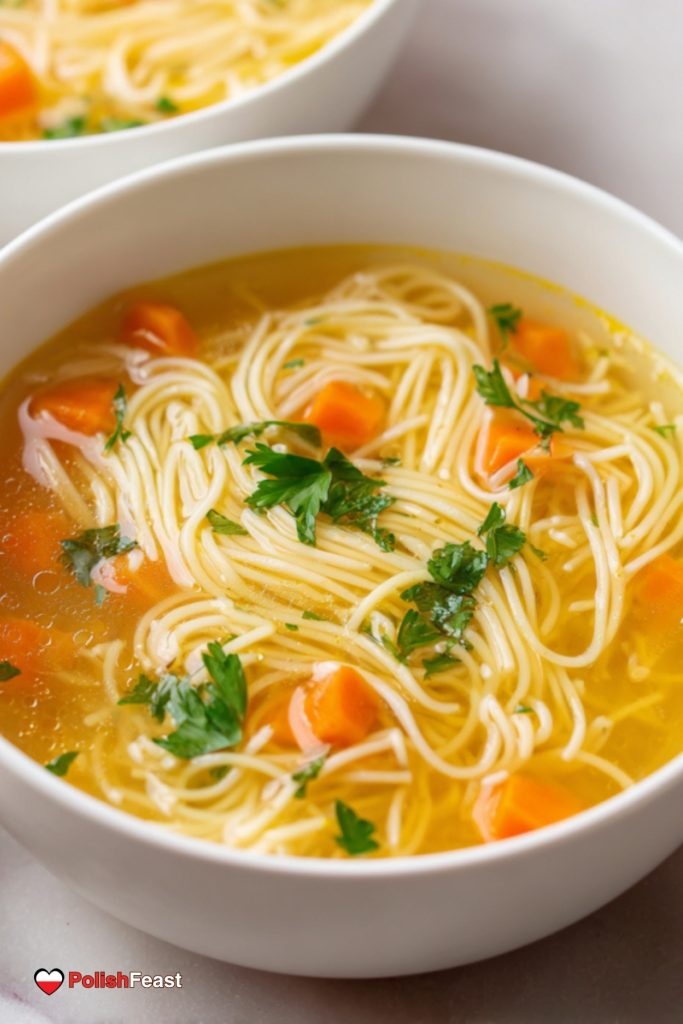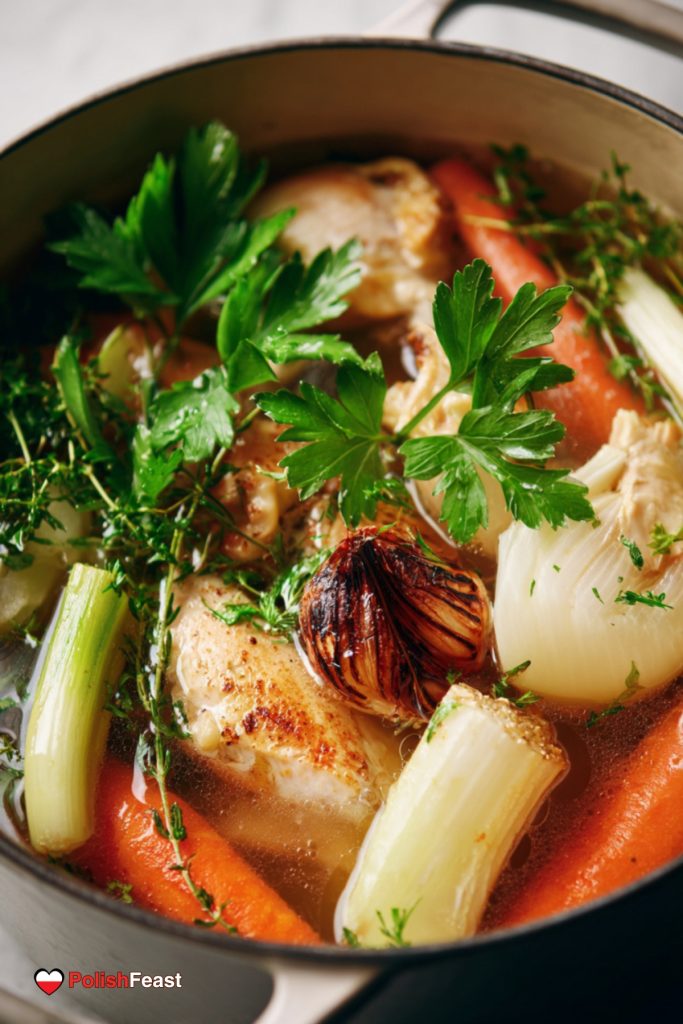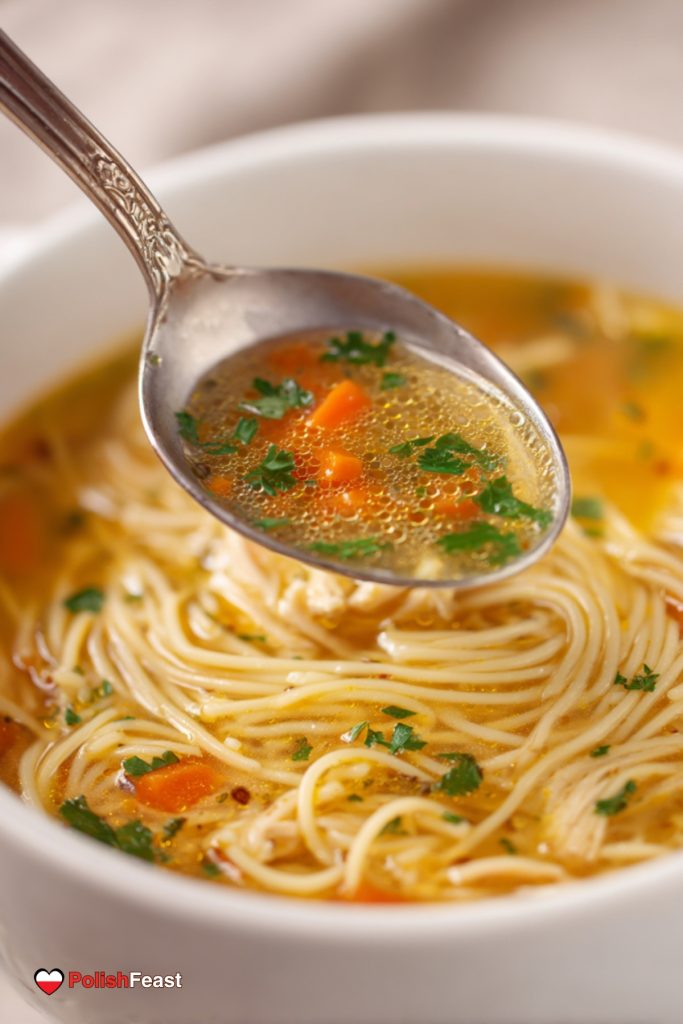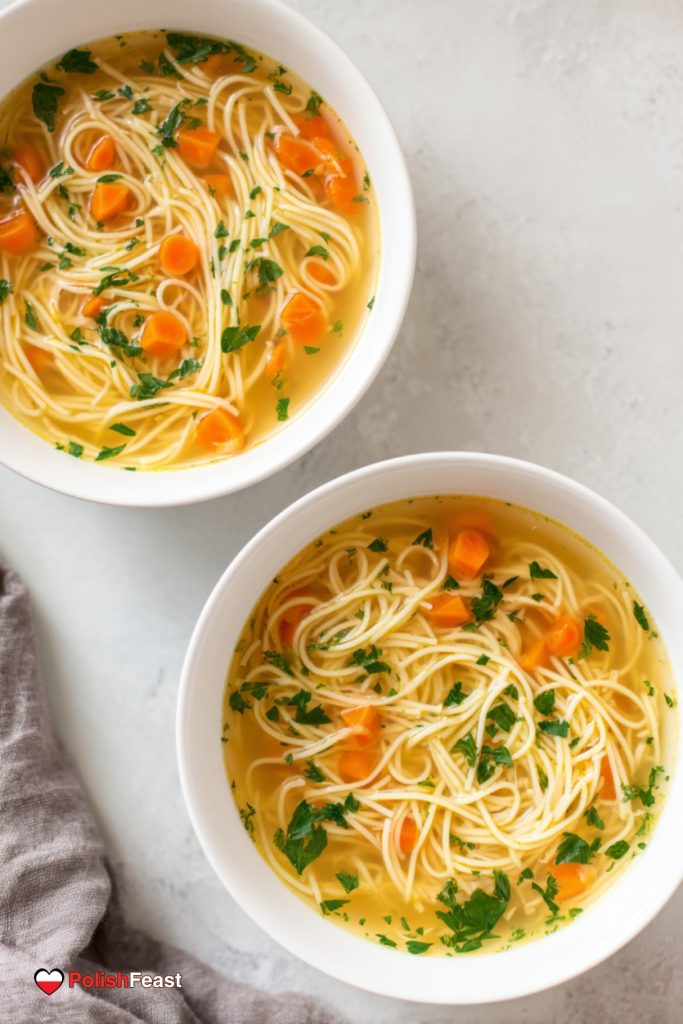Rosół – Polish Chicken Soup Recipe
Posted on
This delicious traditional Rosół recipe is the best Polish Chicken Noodle Soup you will ever try! Our classic Polish Rosół will taste just as babcia used to make it.

Subscribe to Polish Feast Newsletter!
Do you love Polish Recipes? Subscribe to our newsletter and we will send you the most delicious recipes on your inbox!
What Is Rosół?
Rosół (pronounced roh-soow) is a traditional Polish chicken soup, that has clear golden broth, simple root vegetables, and delicate flavor. It’s often the first dish served on Sundays or at special family gatherings, especially in colder months. Unlike Western chicken soups that might use chopped vegetables or thick noodles, Polish rosół is all about subtlety: slow-cooked meats, silky broth, and just a touch of angel hair noodles (makaron nitki) or kluski.
This soup has a special place in Polish culture—comfort food at its finest, made with humble ingredients and a lot of heart.
Why I Love Homemade Rosół?
There’s something as comforting to me and my family as a bowl of homemade Rosół, the classic Polish Chicken Noodle Soup. This recipe brings back memories of family gatherings and cozy afternoons. Just like my babcia used to make, this soup is a warm hug in a bowl, filled with tender chicken, nourishing vegetables, and soothing broth.
Making Rosół at home allows you to control the quality of ingredients, making a rich, flavorful broth that’s both healthy and satisfying. The process of slowly simmering the chicken and vegetables not only fills the kitchen with a delicious aroma but also gives you a broth that’s full of depth and love.
Traditionally Polish Rosół is served on a Sunday, as a „First dish” usually followed by a main dish with meat, potatoes and vegetables. I can honestly say that Polish Chicken Soup is my nr 1 soup out of every cuisine!
Key Ingredients & Substitutions
- Chicken: Whole chicken or mixed parts like wings, thighs, and neck add flavor and fat for that golden broth. You can also use chicken backs or carcasses.
- Beef (optional): A small piece of beef adds richness, but skip it if you prefer a lighter flavor.
- Parsley root: A classic in Polish soups. Can’t find it? Use parsnip — similar texture, just a bit sweeter.
- Celery root (celeriac): Adds subtle earthiness. If unavailable, swap in celery stalks — just use a bit more.
- Leek: Adds a mild, oniony depth.
- Onion with skin: Adds color and flavor — leave the peel on when adding it to the pot! (But make sure to wash it very well if you do so!)
- Spices: Whole allspice berries and peppercorns are traditional; don’t use ground spices here.
- Noodles: Very fine egg noodles or angel hair pasta. Always cook them separately so the broth stays clear.
- Fresh parsley: A sprinkle on top brings brightness and color.

Expert Tips for Perfect Rosół
Start with Cold Water: Begin by covering your chicken and optional beef with cold water. This helps in extracting maximum flavor from the meats and bones, leading to a richer broth, as well as creating a perfect clear broth.
Low and Slow: The secret to a clear, flavorful broth is to cook it on a low simmer. This patience pays off with a soup that’s full of depth.
Skim the Foam: Regularly skimming off any foam and impurities that rise to the surface ensures your broth stays clear and beautiful.
Roast or toast the onion: If You want a more intense flavor, i recommend to roast the onions in the oven, or to toast them on a dry pan, until they turn golden and aromatic.
Use Whole Vegetables: Adding whole vegetables like carrots, parsley root, and celery root contributes to the soup’s complexity of flavors. You can add a full (washed) onion with the skin on, for a rich and golden color.
Strain for Clarity: Straining the broth through a fine-mesh sieve or cheesecloth guarantees a clear, clean-tasting soup that looks as good as it tastes. (But remember to strain it into another pot :D! I need to admit it i poured the soup down the drain one time haha – Never again!)
Make „Pomidorowa” the next day: Because rosół is a perfect base for other soup, I recommend adding a few tablespoons of tomato paste, and making a delicious Tomato soup. You can also use the broth to make other soups like Traditional Polish Borscht, or Polish Zupa Ogórkowa (Dill Pickle Soup).

Common Mistakes to Avoid
- Boiling the soup: Boiling makes the broth cloudy and muddled. Keep it at a gentle simmer the entire time.
- Adding salt too early: Adding salt at the beginning can prevent the proteins from releasing fully and can make the soup cloudy. I like to add most of the salt at the end.
- Not skimming the foam: The foam that rises in the first 30–40 minutes should be skimmed regularly. It’s key to a clear, clean broth.
- Cooking the noodles in the broth: Always boil noodles separately. Cooking them in the soup releases starch, which makes the broth cloudy and gummy.
How to Properly Store Rosół?
Storing Rosół correctly means you can enjoy this comforting soup over several days. Here’s how:
Cool Completely: After cooking, let the soup cool to room temperature. You can do this more quickly by placing the pot in a sink filled with ice water. This helps prevent bacteria growth.
Separate for Storage: Store the broth and solid ingredients like chicken and vegetables separately in airtight containers. This keeps the ingredients from becoming too soft and ensures the broth stays clear, and good for longer.
Refrigerate: After placing rosół in glass jars or tightly sealed plastic containers, place them in the fridge for up to 3-4 days.
Freeze the broth: The broth is perfect for using in other dishes, like risotto, other soups and sauces and more. Strain the broth, freeze it in ice cube trays, and transfer to ziplocks. Store up to 4 months.

FAQ
What is Rosół traditionally made of?
Rosół is traditionally made of a whole chicken or a mix of chicken parts like legs, thighs, and wings, sometimes with the addition of beef. It’s simmered with root vegetables (carrots, parsley root, celery root), leek, garlic, fresh parsley, and spices such as bay leaves, allspice, and black peppercorns.
Do you cook the chicken before putting it in soup?
There is no need for precooking the chicken if you boil the soup slowly, without the lid, and You skin all of the impurities that float to the top.
Why is my Rosół cloudy?
Cloudy Rosół is caused by the lack of taking out the impurities that float to the top from the meat, as well as too strong boil. You want the soup to be slowly simmering, and skimming it every 10 minutes, in the beginning.
